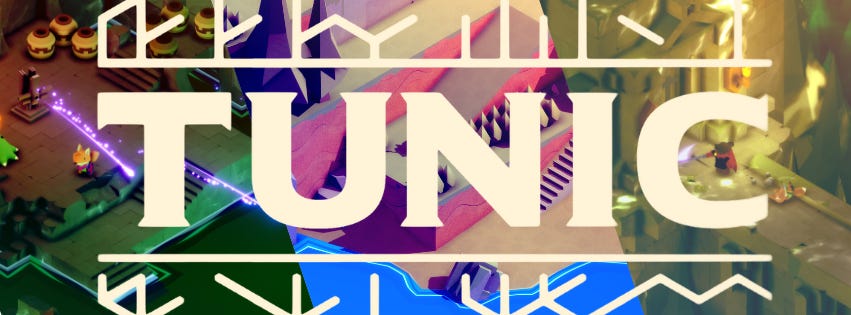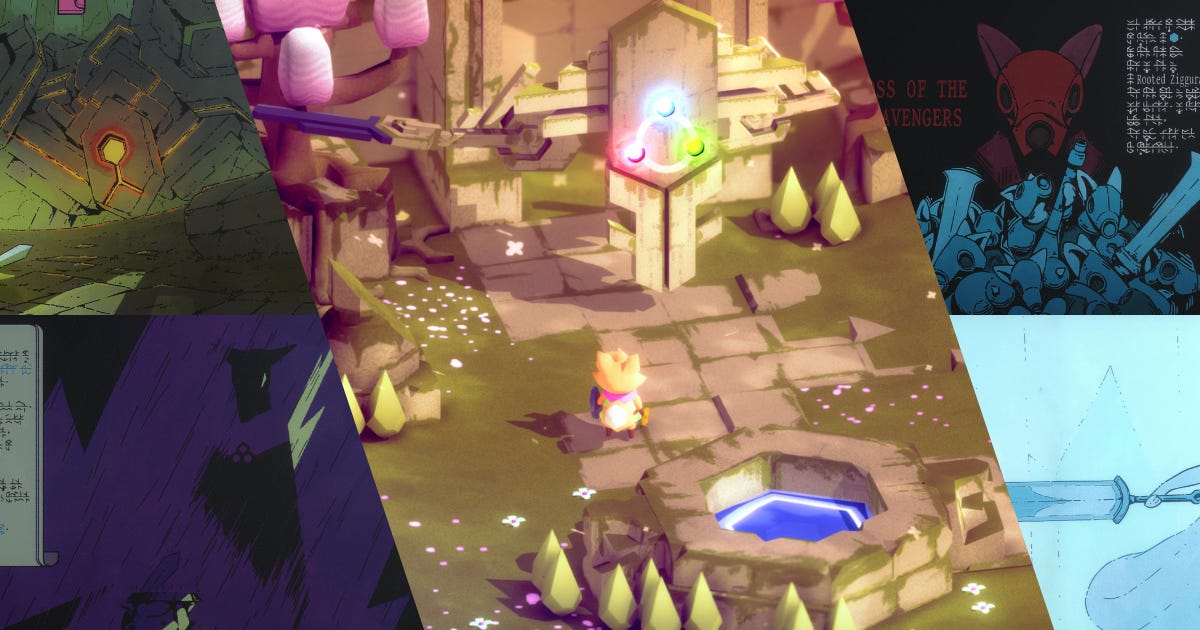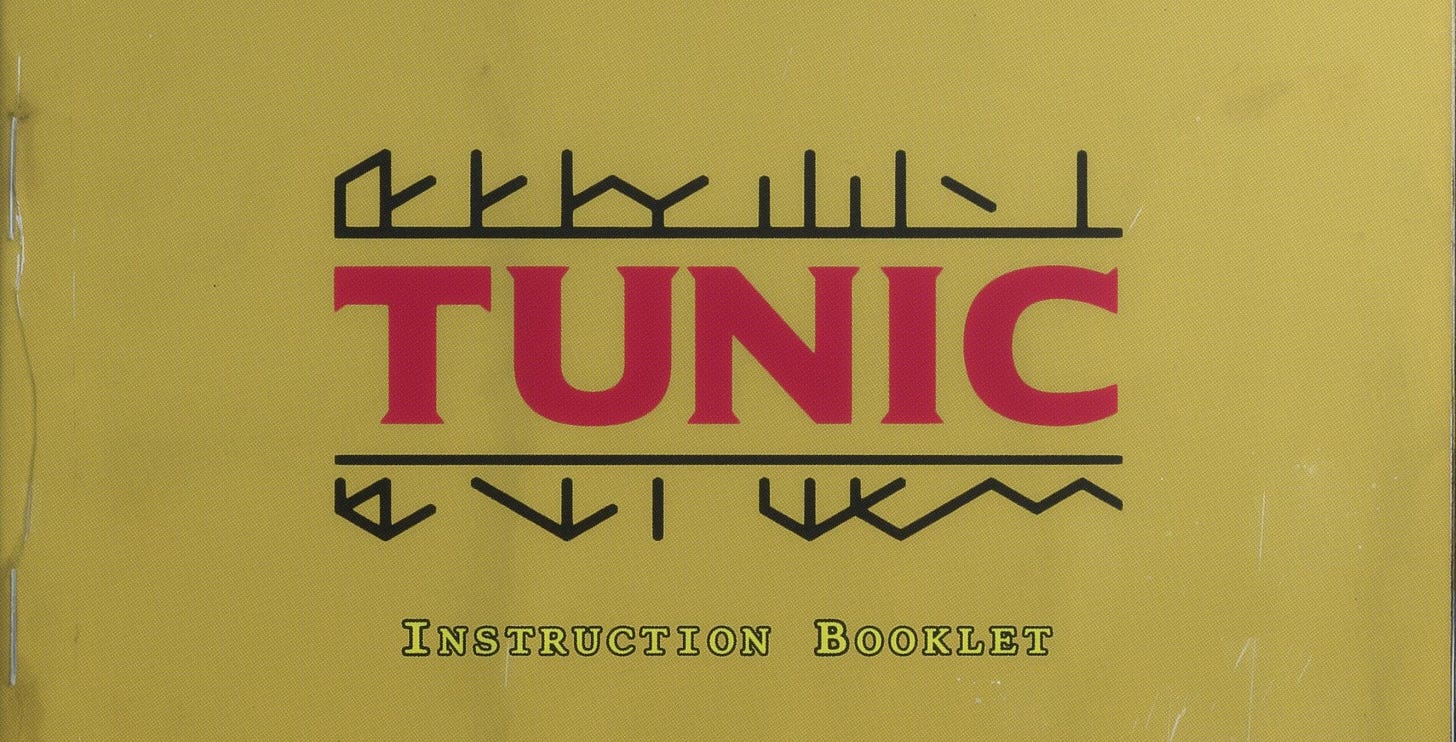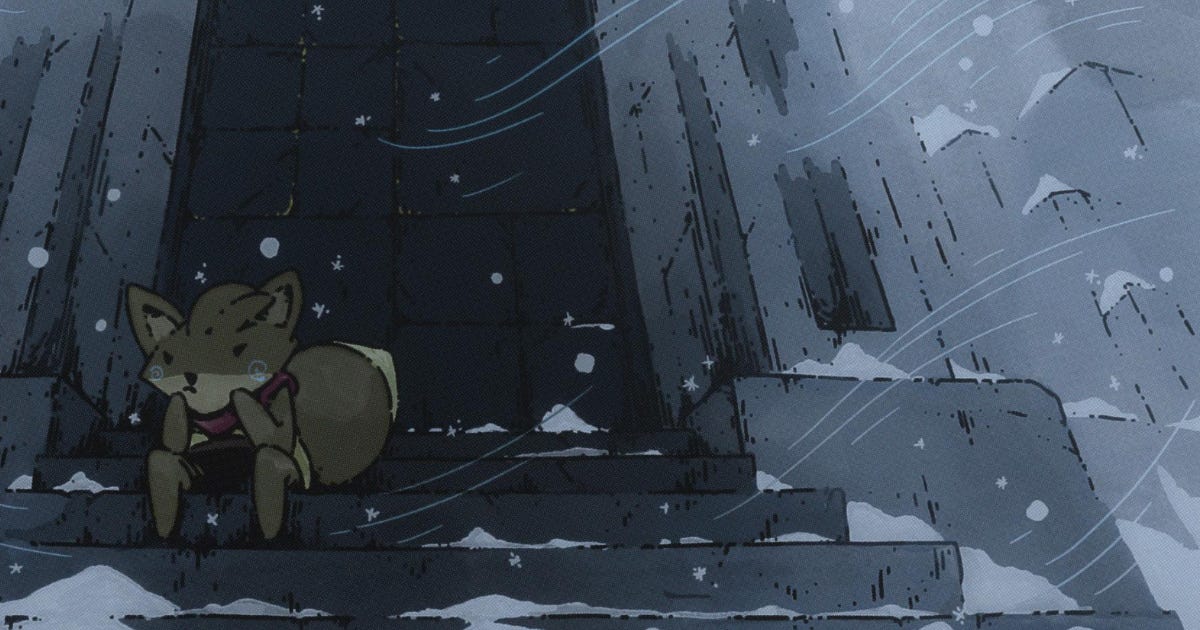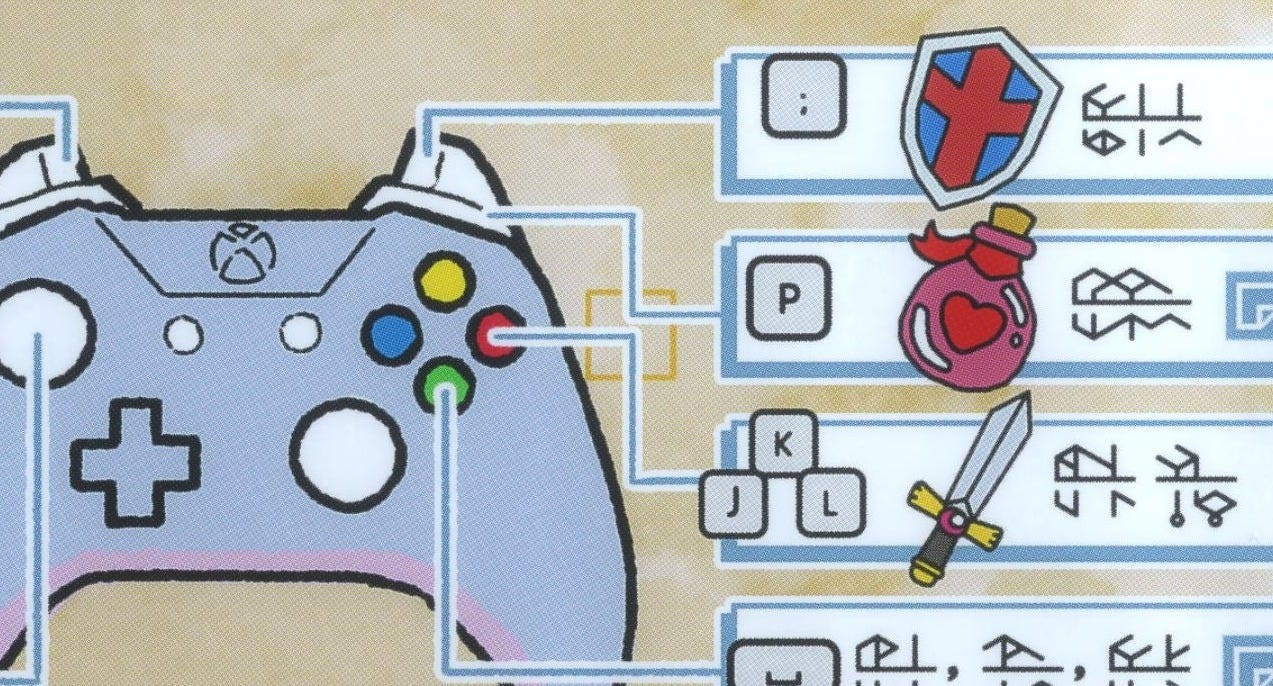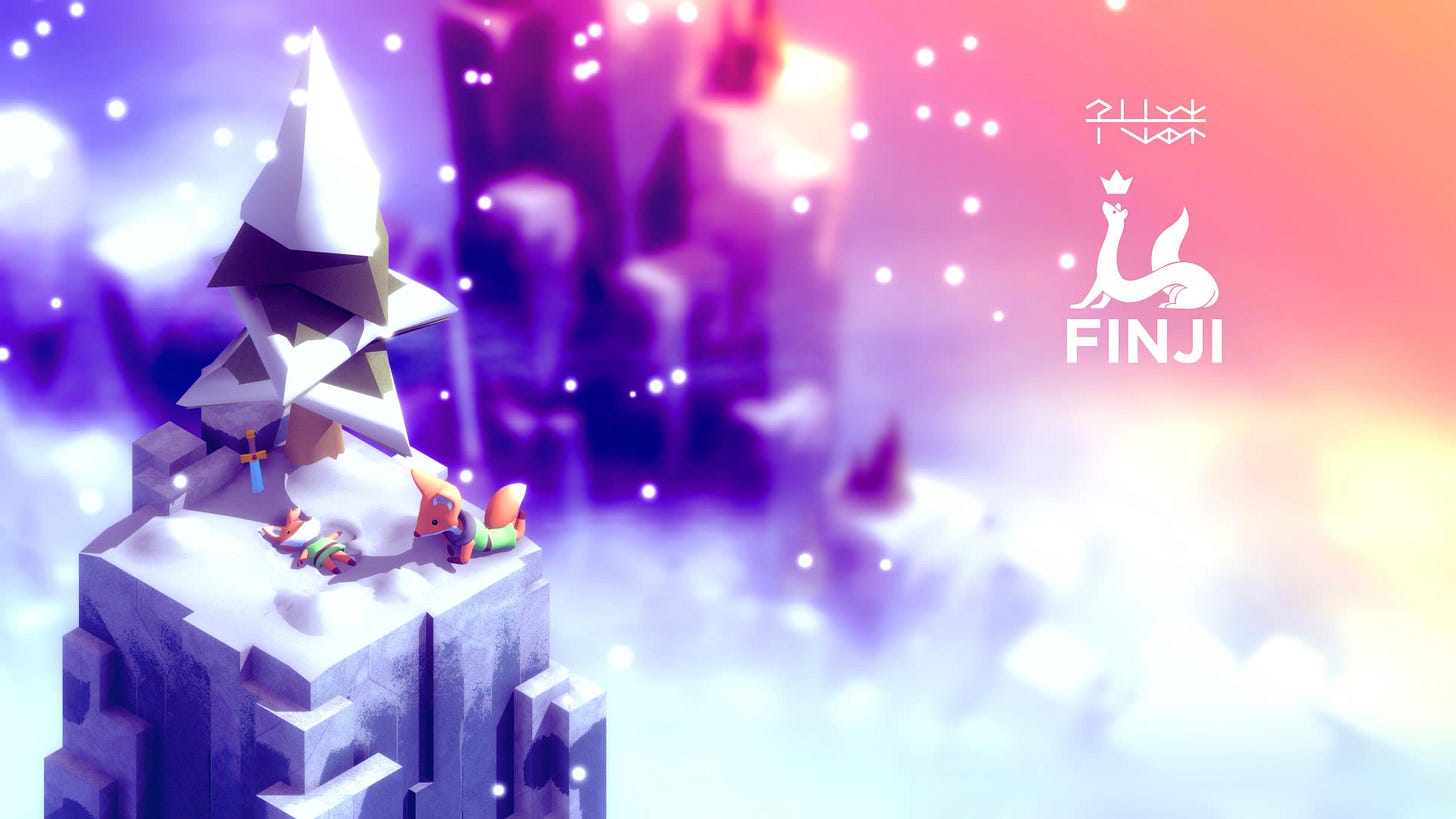This will include full spoilers for the game Tunic. If you are at all interested in playing this game I highly recommend you do (and then come back and read this).
I also highly recommend you play Tunic as blind as possible, as most of the game is about solving puzzles and discovering the game as you progress. If you can, don’t use guides, and let the game tell you what it wants you to know.
Even while looking for images for this I stumbled upon some light spoilers so I recommend you stay head down till you can play it!
The subtitle of this review is not hyperbole or click-bait. Tunic is, without a doubt a top contender for the best game I’ve ever played.
Background
Tunic is a top down action adventure game that takes heavy inspiration from Zelda, Dark Souls, and even FEZ. It has an undeniably good style that has a subtle tilt-shift look, but it doesn’t rely on that. The polygonal models and world match well with the bright, lush lighting and vibrant colors.
This game was developed by Isometricorp Games, a team made up of only two developers and a handful of audio and music composers.
The game started as a solo development project for Andrew Shouldice in 2015. He would continue to work on the game for 7 years. He wanted to create something that was evocative of his childhood experience with games like The Legend of Zelda (NES) and the game manuals from that time.
When the game was released, I wasn’t into video games the way I am now. It came out a month after Elden Ring and that was all that I cared about. The release of this game was likely overshadowed by the behemoth of Elden Ring, and I think that’s a real shame.
The Loop
The loop of Tunic is similar to a Zelda game, you find an obstacle that you can’t over come without a specific item so you find the item.
Early on in Tunic, it’s a sword. You can’t get to where you need to go without chopping down a bush with a sword (if you’re taking the typical route). In Zelda games, the items are usually tied to a dungeon. You show up at a place, find a new item, use that item to get through the dungeon and now you can use that item to get to new locations throughout the map.
As the game develops however, it becomes much more than that. I’ll get into this later, but there are a lot of puzzles and secrets in this game to discover. As you explore more of the world you slowly unravel it and the game becomes more about these secrets (and using a physical notebook) then it does the typical Zelda loop.
Combat
The combat in Tunic is much like the 3d Zelda games. You have a sword and a shield and you can dodge. However, as the game progresses the combat begins to feel more like Dark Souls then Zelda.
Big enemies have large telegraphed swings you’ll need to dodge while waiting for the perfect opportunity to get a couple of hits in. We’ll talk more about the game’s combat further down the page.
The Manual
So far this explanation of Tunic sounds a lot like an amalgamation of other games, and while I’d love a distilled version of various genre’s coming together to create a masterpiece, Tunic does a lot more.
Tunic’s manual mechanic is one of my favorite additions to the game. Instead of having to signpost what the player needs to do next with hints or clues throughout the world, or drip-feeding information through NPCs, Tunic uses The Manual.
Do you remember Prima Strategy guides? Those old chunky manuals that walk you through how to play through a game. These were incredibly helpful for older games - they used to be so much more obtuse!
Nowadays, we don’t need strategies for games. If someone gets stuck, they can always use Google to find the solution. Because physical guides are no longer needed, they’ve become a source of nostalgia for so many.
Tunic provokes the feelings of using an old-school game manual by including a manual within the game. However, the pages are scattered throughout the world.
The first pages you’ll find explain the controls of the game and some simple mechanics, but it’s possible to find pages before understanding the context of what it’s about.
For example, I found the map for a second location before knowing how to get there. When moments like this happens it’s like a carrot dangling in front of you. You know there’s more to see, you just haven’t seen it yet.
Some other pages you can find explain the lore of the game. There’s one page in particular that when I found made me piece together a pretty big story moment that had not happened yet.
Finally, some pages have penciled in notes. Some of the maps have markings left by someone who, a assume, played the game before me. It’s like finding an old guide with notes left from a forgotten player.
The manual of Tunic lets the player put together puzzles and organically find goals to pursue.
I think about my time with Golden Sun: The Lost Age. That game is so open. Once you get to a certain point in the game the player is told to just wander around for a little bit. While I love this game, I don’t have time to wander around it’s very big overworld. Therefore, an online guide is very helpful.
Tunic’s in-game manual is the perfect response to the experience of getting lost in a game and having to look up an online guide.
I could spent the rest of this just talking about how good Tunic’s manual is, but there is so much more to talk about.
A Big World and A Tiny Hero
You wake up on a lonely beach.
It’s quiet, you feel lost, and (most notably) small.
The Scenery is lush and green, and there are things that can hurt you.
The opening moments of Tunic are all about getting your bearings. There’s no tutorial. Instead, players are tasked with figuring out the initial controls. Experienced players will recognize the health and stamina bar and shouldn’t have a hard time finding the dodge and run button.
The first weapon you find is a stick. It can protect you from weaker enemies, but it can’t do much against larger ones and bushes.
At first, you don’t have anywhere to go except toward a massive golden door. Upon arrival, you get teleported to a strange shattered world. At the end of this area is a large anthropomorphic fennec fox-looking figure trapped in a geometric prismatic vault (thing). As the player character walks up to the figure, she wakes up. It’s made obvious that she’s trapped. This is where the Zelda comparison goes beyond the look and gameplay.
It’s pretty typical for Zelda to be trapped in a gem (thing?) and Link is tasked to find items that will break her free. As an experienced gamer, this opening sequence told me - I need to find the gems and break this fox out of this prism. However, the way back in is locked.
Ringing The Bells
With the help of the manuals, it’s not hard to learn that you need to ring a couple of bells across the map to open the big golden door. This part of the game acts as the tutorial and it’s relatively straight-forward.
To ring these bells there are two bosses you must over come. the first is not very difficult and I’m hard pressed to call it a boss. Yeah it has a life bar, but it’s nothing too crazy.
The second boss? The Garden Knight? That guy is tough.
I wouldn’t be surprised if this boss sifts out a lot of players from continuing the game. It’s a much different fight than anything else the game has challenged the player with yet, and it requires a lot.
Personally, I beat the Garden Knight by using the first magical item you get just moments before the boss. The Ice Dagger. It lets you freeze enemies so you can either back away and get some healing in, or wail on them. I used it primarily to buy a couple of seconds to heal and ended up beating him by throwing way too many firecrackers. This did kill me, but it worked!
Finding the Gems
After you’ve finished ringing the bells you’re met with a new problem to solve. The golden door has opened, but there’s nothing to do in there. Instead of being teleported to that other space, you get a manual page that gives you more information.
Instead of just ringing the bells and opening the door, you need to find 3 gems. This is the meat of the game.
On your journey to find the gems, you’ll find new items, and face some really challenging bosses. You might find some secrets, but you’ll always be learning more about the game.
More Gushing About Tunic: What I loved
That’s all that I’ll say in the explainer section. Let’s get into My experience with Tunic.
The Manual (obviously)
It shouldn’t be a surprise that Tunic’s manual is my favorite part of the game. Every time I found a new page I would look over all the information and learn something new. I love how the manual looks too. There are some maps that look straight out a DND zine and that gives it just a bit of character that I love dearly.
Hidden Secrets in Plain Site
There is so much available to the player before they even know it. This goes for certain powers and hidden shortcuts. More than once I got to the end of an area and followed a secret path that led me back to where I started. These paths aren’t the traditional shortcuts in a DarkSouls game, they are available to use whenever you just can’t see them easily.
Big Secrets and Overarching Puzzles
There is a lot to decipher in Tunic. I mentioned that the manual is mostly in a runic language, that language can be deciphered! I haven’t done this, and I don’t know if I will, but it’s a big example that this game goes beyond actually playing it.
Toward the end of the game I spend multiple sessions just looking at the manual and making notes in my real life notebook. This game is a thinker and I love it.
Big Spoilers
My favorite puzzle in this game is the golden path. On one of the pages there’s a golden block with a grid in it. Each square has a number and it’s obvious it has something to do with opening the big door on top of the mountain.
I stared at this grid for a long time, thinking about prime numbers and trying to find any correlation between them. The first number was 12 and the adjacent squares didn’t seem to be related at all.
Eventually, I turned to page 12, maybe there was a hint on the page. This page shows a controller with the basic controls and I had seen it before. What I didn’t notice before was a small golden square.
That’s when I solved it. Each numbered square corresponded to a manual page number and on each page there was a hidden golden path. When put together, it created a massive path the player had to trace in order to open the big door and get the final manual page.
I was floored when I discovered this.
Final Thoughts
Most people will say that Tunic has bosses that are too punishing, and I do have to agree. However, the time I had spent doing everything else far outweighed the frustration I felt when facing against the bosses. If that frustration wasn’t there I do think I would have enjoyed the game that much more. However, I think it’s perfect as is.
If you are having issues with the bosses, try exploring some more, there are items that make the bosses a bit easier (especially the final boss pg. 47)
I love this game.
That’s all.



